Mental Health Disparity Research 2022
VerifiedAdded on 2022/09/28
|8
|2267
|23
AI Summary
Contribute Materials
Your contribution can guide someone’s learning journey. Share your
documents today.
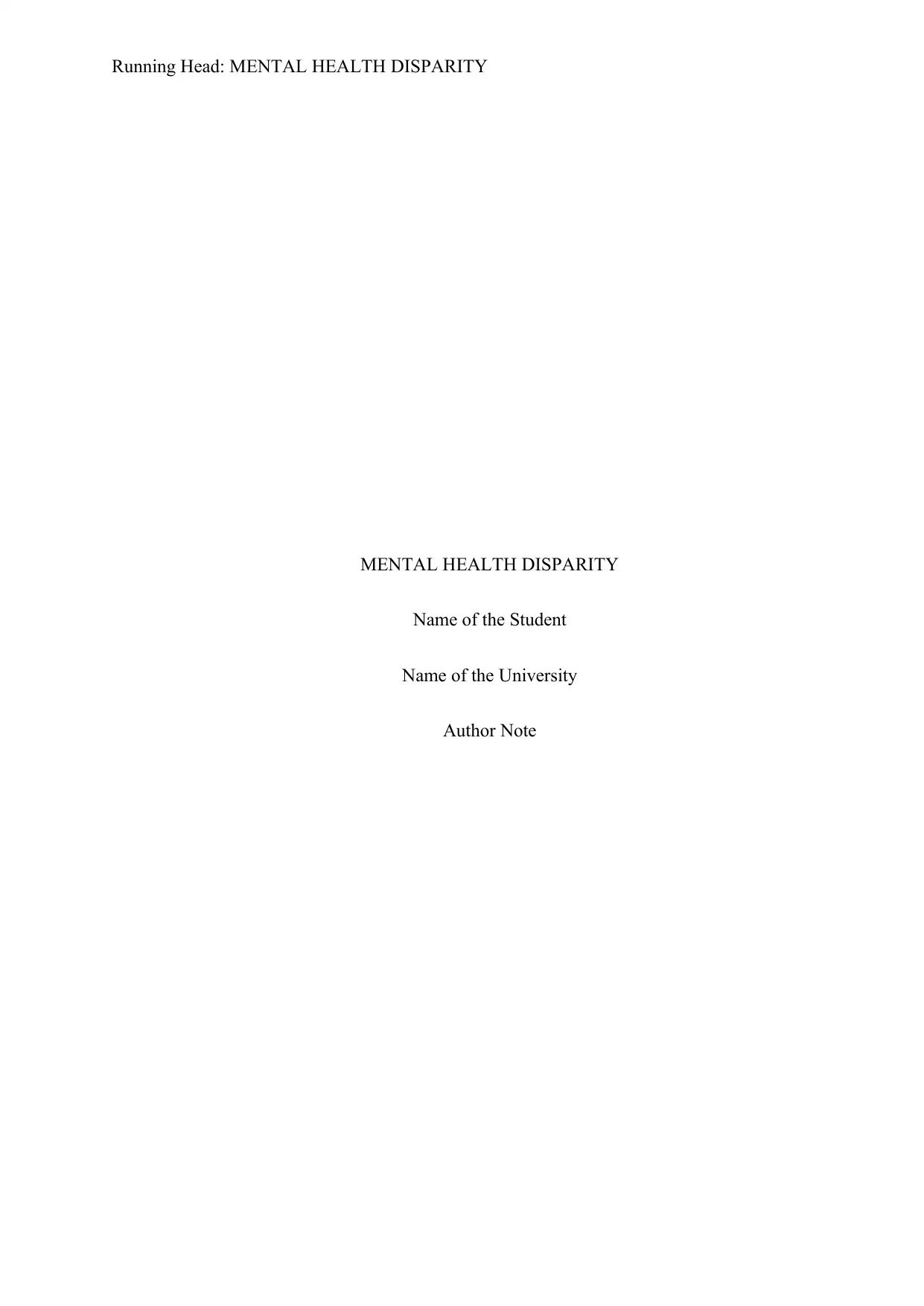
Running Head: MENTAL HEALTH DISPARITY
MENTAL HEALTH DISPARITY
Name of the Student
Name of the University
Author Note
MENTAL HEALTH DISPARITY
Name of the Student
Name of the University
Author Note
Secure Best Marks with AI Grader
Need help grading? Try our AI Grader for instant feedback on your assignments.
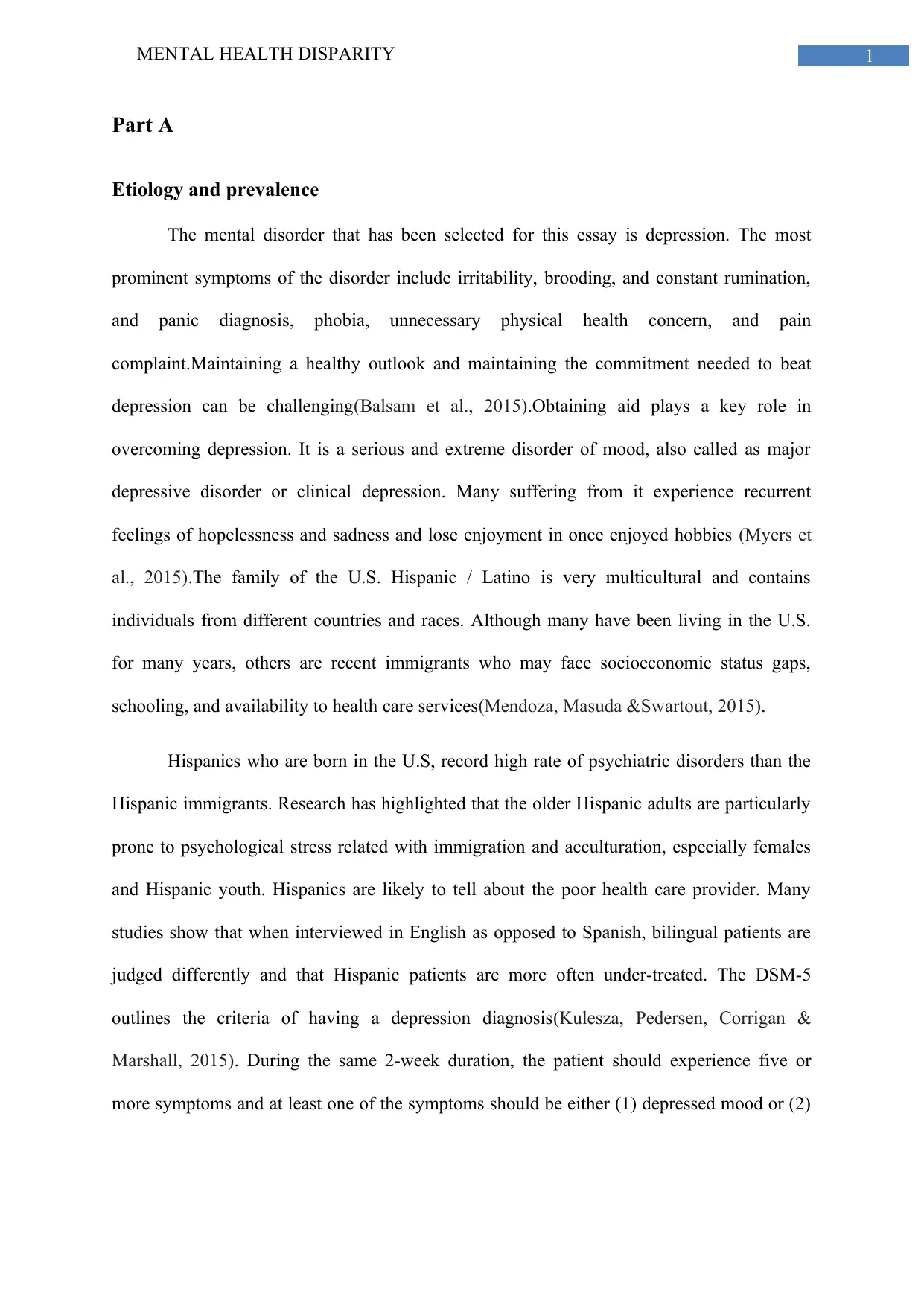
1MENTAL HEALTH DISPARITY
Part A
Etiology and prevalence
The mental disorder that has been selected for this essay is depression. The most
prominent symptoms of the disorder include irritability, brooding, and constant rumination,
and panic diagnosis, phobia, unnecessary physical health concern, and pain
complaint.Maintaining a healthy outlook and maintaining the commitment needed to beat
depression can be challenging(Balsam et al., 2015).Obtaining aid plays a key role in
overcoming depression. It is a serious and extreme disorder of mood, also called as major
depressive disorder or clinical depression. Many suffering from it experience recurrent
feelings of hopelessness and sadness and lose enjoyment in once enjoyed hobbies (Myers et
al., 2015).The family of the U.S. Hispanic / Latino is very multicultural and contains
individuals from different countries and races. Although many have been living in the U.S.
for many years, others are recent immigrants who may face socioeconomic status gaps,
schooling, and availability to health care services(Mendoza, Masuda &Swartout, 2015).
Hispanics who are born in the U.S, record high rate of psychiatric disorders than the
Hispanic immigrants. Research has highlighted that the older Hispanic adults are particularly
prone to psychological stress related with immigration and acculturation, especially females
and Hispanic youth. Hispanics are likely to tell about the poor health care provider. Many
studies show that when interviewed in English as opposed to Spanish, bilingual patients are
judged differently and that Hispanic patients are more often under-treated. The DSM-5
outlines the criteria of having a depression diagnosis(Kulesza, Pedersen, Corrigan &
Marshall, 2015). During the same 2-week duration, the patient should experience five or
more symptoms and at least one of the symptoms should be either (1) depressed mood or (2)
Part A
Etiology and prevalence
The mental disorder that has been selected for this essay is depression. The most
prominent symptoms of the disorder include irritability, brooding, and constant rumination,
and panic diagnosis, phobia, unnecessary physical health concern, and pain
complaint.Maintaining a healthy outlook and maintaining the commitment needed to beat
depression can be challenging(Balsam et al., 2015).Obtaining aid plays a key role in
overcoming depression. It is a serious and extreme disorder of mood, also called as major
depressive disorder or clinical depression. Many suffering from it experience recurrent
feelings of hopelessness and sadness and lose enjoyment in once enjoyed hobbies (Myers et
al., 2015).The family of the U.S. Hispanic / Latino is very multicultural and contains
individuals from different countries and races. Although many have been living in the U.S.
for many years, others are recent immigrants who may face socioeconomic status gaps,
schooling, and availability to health care services(Mendoza, Masuda &Swartout, 2015).
Hispanics who are born in the U.S, record high rate of psychiatric disorders than the
Hispanic immigrants. Research has highlighted that the older Hispanic adults are particularly
prone to psychological stress related with immigration and acculturation, especially females
and Hispanic youth. Hispanics are likely to tell about the poor health care provider. Many
studies show that when interviewed in English as opposed to Spanish, bilingual patients are
judged differently and that Hispanic patients are more often under-treated. The DSM-5
outlines the criteria of having a depression diagnosis(Kulesza, Pedersen, Corrigan &
Marshall, 2015). During the same 2-week duration, the patient should experience five or
more symptoms and at least one of the symptoms should be either (1) depressed mood or (2)
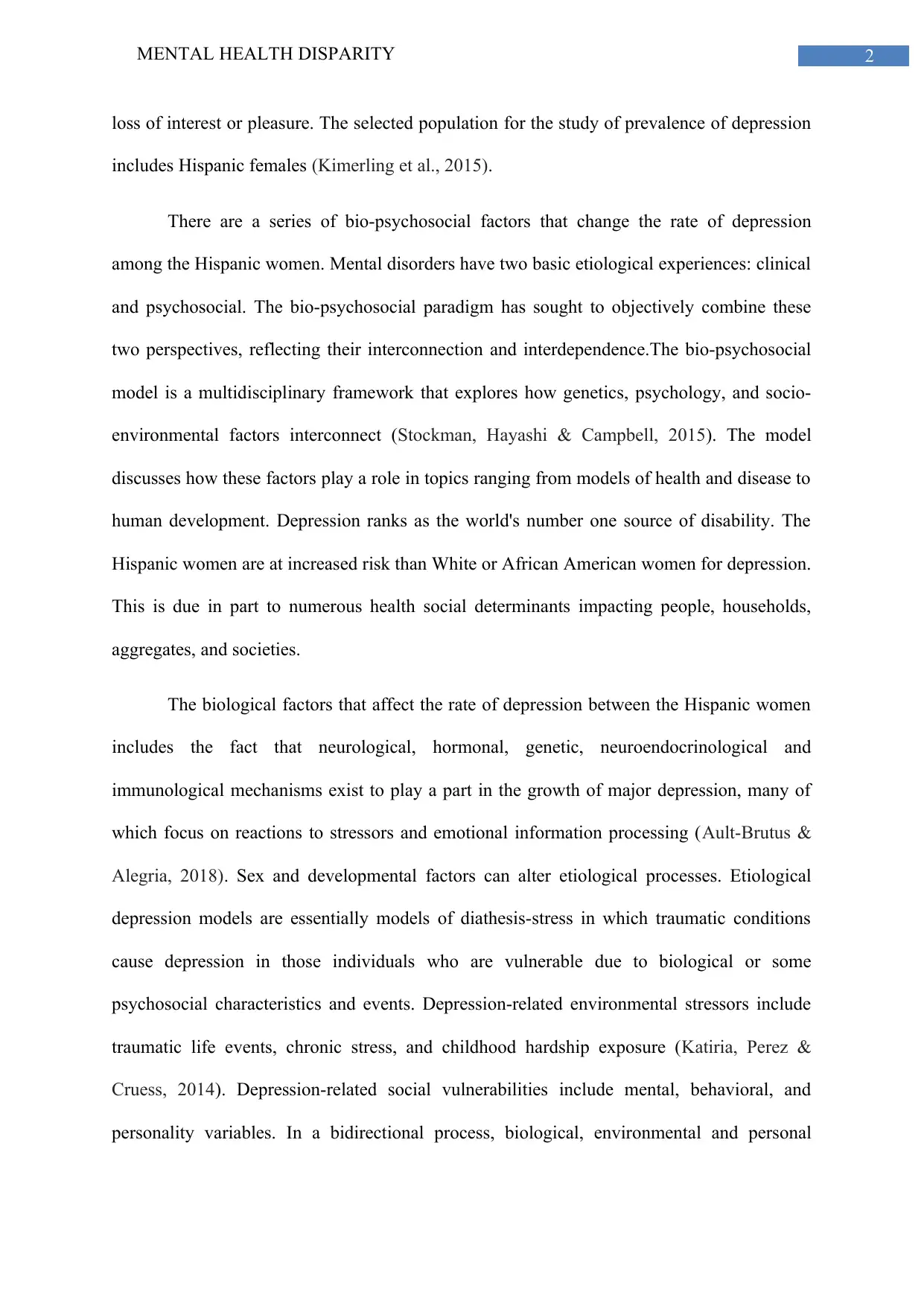
2MENTAL HEALTH DISPARITY
loss of interest or pleasure. The selected population for the study of prevalence of depression
includes Hispanic females (Kimerling et al., 2015).
There are a series of bio-psychosocial factors that change the rate of depression
among the Hispanic women. Mental disorders have two basic etiological experiences: clinical
and psychosocial. The bio-psychosocial paradigm has sought to objectively combine these
two perspectives, reflecting their interconnection and interdependence.The bio-psychosocial
model is a multidisciplinary framework that explores how genetics, psychology, and socio-
environmental factors interconnect (Stockman, Hayashi & Campbell, 2015). The model
discusses how these factors play a role in topics ranging from models of health and disease to
human development. Depression ranks as the world's number one source of disability. The
Hispanic women are at increased risk than White or African American women for depression.
This is due in part to numerous health social determinants impacting people, households,
aggregates, and societies.
The biological factors that affect the rate of depression between the Hispanic women
includes the fact that neurological, hormonal, genetic, neuroendocrinological and
immunological mechanisms exist to play a part in the growth of major depression, many of
which focus on reactions to stressors and emotional information processing (Ault-Brutus &
Alegria, 2018). Sex and developmental factors can alter etiological processes. Etiological
depression models are essentially models of diathesis-stress in which traumatic conditions
cause depression in those individuals who are vulnerable due to biological or some
psychosocial characteristics and events. Depression-related environmental stressors include
traumatic life events, chronic stress, and childhood hardship exposure (Katiria, Perez &
Cruess, 2014). Depression-related social vulnerabilities include mental, behavioral, and
personality variables. In a bidirectional process, biological, environmental and personal
loss of interest or pleasure. The selected population for the study of prevalence of depression
includes Hispanic females (Kimerling et al., 2015).
There are a series of bio-psychosocial factors that change the rate of depression
among the Hispanic women. Mental disorders have two basic etiological experiences: clinical
and psychosocial. The bio-psychosocial paradigm has sought to objectively combine these
two perspectives, reflecting their interconnection and interdependence.The bio-psychosocial
model is a multidisciplinary framework that explores how genetics, psychology, and socio-
environmental factors interconnect (Stockman, Hayashi & Campbell, 2015). The model
discusses how these factors play a role in topics ranging from models of health and disease to
human development. Depression ranks as the world's number one source of disability. The
Hispanic women are at increased risk than White or African American women for depression.
This is due in part to numerous health social determinants impacting people, households,
aggregates, and societies.
The biological factors that affect the rate of depression between the Hispanic women
includes the fact that neurological, hormonal, genetic, neuroendocrinological and
immunological mechanisms exist to play a part in the growth of major depression, many of
which focus on reactions to stressors and emotional information processing (Ault-Brutus &
Alegria, 2018). Sex and developmental factors can alter etiological processes. Etiological
depression models are essentially models of diathesis-stress in which traumatic conditions
cause depression in those individuals who are vulnerable due to biological or some
psychosocial characteristics and events. Depression-related environmental stressors include
traumatic life events, chronic stress, and childhood hardship exposure (Katiria, Perez &
Cruess, 2014). Depression-related social vulnerabilities include mental, behavioral, and
personality variables. In a bidirectional process, biological, environmental and personal
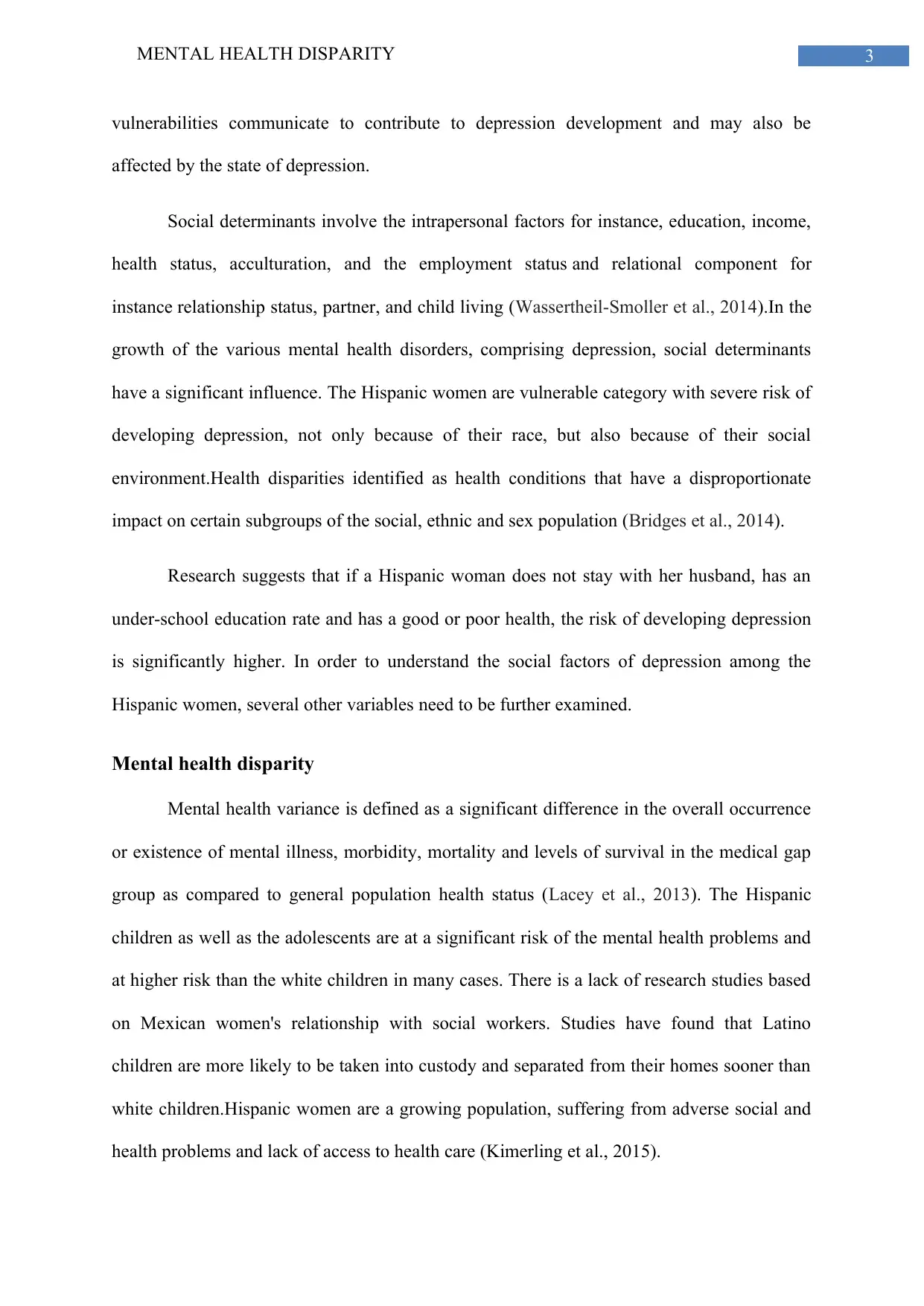
3MENTAL HEALTH DISPARITY
vulnerabilities communicate to contribute to depression development and may also be
affected by the state of depression.
Social determinants involve the intrapersonal factors for instance, education, income,
health status, acculturation, and the employment status and relational component for
instance relationship status, partner, and child living (Wassertheil-Smoller et al., 2014).In the
growth of the various mental health disorders, comprising depression, social determinants
have a significant influence. The Hispanic women are vulnerable category with severe risk of
developing depression, not only because of their race, but also because of their social
environment.Health disparities identified as health conditions that have a disproportionate
impact on certain subgroups of the social, ethnic and sex population (Bridges et al., 2014).
Research suggests that if a Hispanic woman does not stay with her husband, has an
under-school education rate and has a good or poor health, the risk of developing depression
is significantly higher. In order to understand the social factors of depression among the
Hispanic women, several other variables need to be further examined.
Mental health disparity
Mental health variance is defined as a significant difference in the overall occurrence
or existence of mental illness, morbidity, mortality and levels of survival in the medical gap
group as compared to general population health status (Lacey et al., 2013). The Hispanic
children as well as the adolescents are at a significant risk of the mental health problems and
at higher risk than the white children in many cases. There is a lack of research studies based
on Mexican women's relationship with social workers. Studies have found that Latino
children are more likely to be taken into custody and separated from their homes sooner than
white children.Hispanic women are a growing population, suffering from adverse social and
health problems and lack of access to health care (Kimerling et al., 2015).
vulnerabilities communicate to contribute to depression development and may also be
affected by the state of depression.
Social determinants involve the intrapersonal factors for instance, education, income,
health status, acculturation, and the employment status and relational component for
instance relationship status, partner, and child living (Wassertheil-Smoller et al., 2014).In the
growth of the various mental health disorders, comprising depression, social determinants
have a significant influence. The Hispanic women are vulnerable category with severe risk of
developing depression, not only because of their race, but also because of their social
environment.Health disparities identified as health conditions that have a disproportionate
impact on certain subgroups of the social, ethnic and sex population (Bridges et al., 2014).
Research suggests that if a Hispanic woman does not stay with her husband, has an
under-school education rate and has a good or poor health, the risk of developing depression
is significantly higher. In order to understand the social factors of depression among the
Hispanic women, several other variables need to be further examined.
Mental health disparity
Mental health variance is defined as a significant difference in the overall occurrence
or existence of mental illness, morbidity, mortality and levels of survival in the medical gap
group as compared to general population health status (Lacey et al., 2013). The Hispanic
children as well as the adolescents are at a significant risk of the mental health problems and
at higher risk than the white children in many cases. There is a lack of research studies based
on Mexican women's relationship with social workers. Studies have found that Latino
children are more likely to be taken into custody and separated from their homes sooner than
white children.Hispanic women are a growing population, suffering from adverse social and
health problems and lack of access to health care (Kimerling et al., 2015).
Secure Best Marks with AI Grader
Need help grading? Try our AI Grader for instant feedback on your assignments.
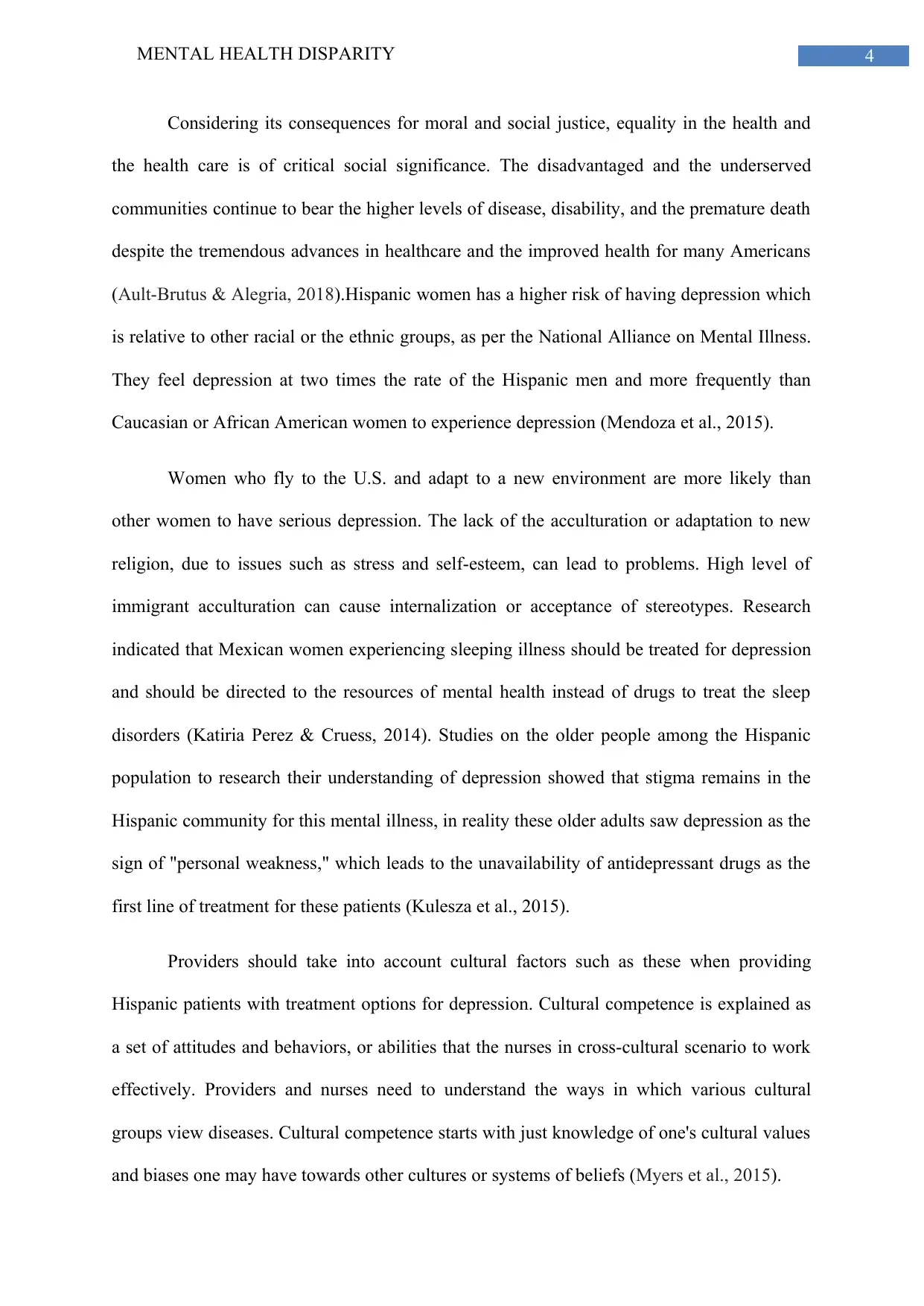
4MENTAL HEALTH DISPARITY
Considering its consequences for moral and social justice, equality in the health and
the health care is of critical social significance. The disadvantaged and the underserved
communities continue to bear the higher levels of disease, disability, and the premature death
despite the tremendous advances in healthcare and the improved health for many Americans
(Ault-Brutus & Alegria, 2018).Hispanic women has a higher risk of having depression which
is relative to other racial or the ethnic groups, as per the National Alliance on Mental Illness.
They feel depression at two times the rate of the Hispanic men and more frequently than
Caucasian or African American women to experience depression (Mendoza et al., 2015).
Women who fly to the U.S. and adapt to a new environment are more likely than
other women to have serious depression. The lack of the acculturation or adaptation to new
religion, due to issues such as stress and self-esteem, can lead to problems. High level of
immigrant acculturation can cause internalization or acceptance of stereotypes. Research
indicated that Mexican women experiencing sleeping illness should be treated for depression
and should be directed to the resources of mental health instead of drugs to treat the sleep
disorders (Katiria Perez & Cruess, 2014). Studies on the older people among the Hispanic
population to research their understanding of depression showed that stigma remains in the
Hispanic community for this mental illness, in reality these older adults saw depression as the
sign of "personal weakness," which leads to the unavailability of antidepressant drugs as the
first line of treatment for these patients (Kulesza et al., 2015).
Providers should take into account cultural factors such as these when providing
Hispanic patients with treatment options for depression. Cultural competence is explained as
a set of attitudes and behaviors, or abilities that the nurses in cross-cultural scenario to work
effectively. Providers and nurses need to understand the ways in which various cultural
groups view diseases. Cultural competence starts with just knowledge of one's cultural values
and biases one may have towards other cultures or systems of beliefs (Myers et al., 2015).
Considering its consequences for moral and social justice, equality in the health and
the health care is of critical social significance. The disadvantaged and the underserved
communities continue to bear the higher levels of disease, disability, and the premature death
despite the tremendous advances in healthcare and the improved health for many Americans
(Ault-Brutus & Alegria, 2018).Hispanic women has a higher risk of having depression which
is relative to other racial or the ethnic groups, as per the National Alliance on Mental Illness.
They feel depression at two times the rate of the Hispanic men and more frequently than
Caucasian or African American women to experience depression (Mendoza et al., 2015).
Women who fly to the U.S. and adapt to a new environment are more likely than
other women to have serious depression. The lack of the acculturation or adaptation to new
religion, due to issues such as stress and self-esteem, can lead to problems. High level of
immigrant acculturation can cause internalization or acceptance of stereotypes. Research
indicated that Mexican women experiencing sleeping illness should be treated for depression
and should be directed to the resources of mental health instead of drugs to treat the sleep
disorders (Katiria Perez & Cruess, 2014). Studies on the older people among the Hispanic
population to research their understanding of depression showed that stigma remains in the
Hispanic community for this mental illness, in reality these older adults saw depression as the
sign of "personal weakness," which leads to the unavailability of antidepressant drugs as the
first line of treatment for these patients (Kulesza et al., 2015).
Providers should take into account cultural factors such as these when providing
Hispanic patients with treatment options for depression. Cultural competence is explained as
a set of attitudes and behaviors, or abilities that the nurses in cross-cultural scenario to work
effectively. Providers and nurses need to understand the ways in which various cultural
groups view diseases. Cultural competence starts with just knowledge of one's cultural values
and biases one may have towards other cultures or systems of beliefs (Myers et al., 2015).
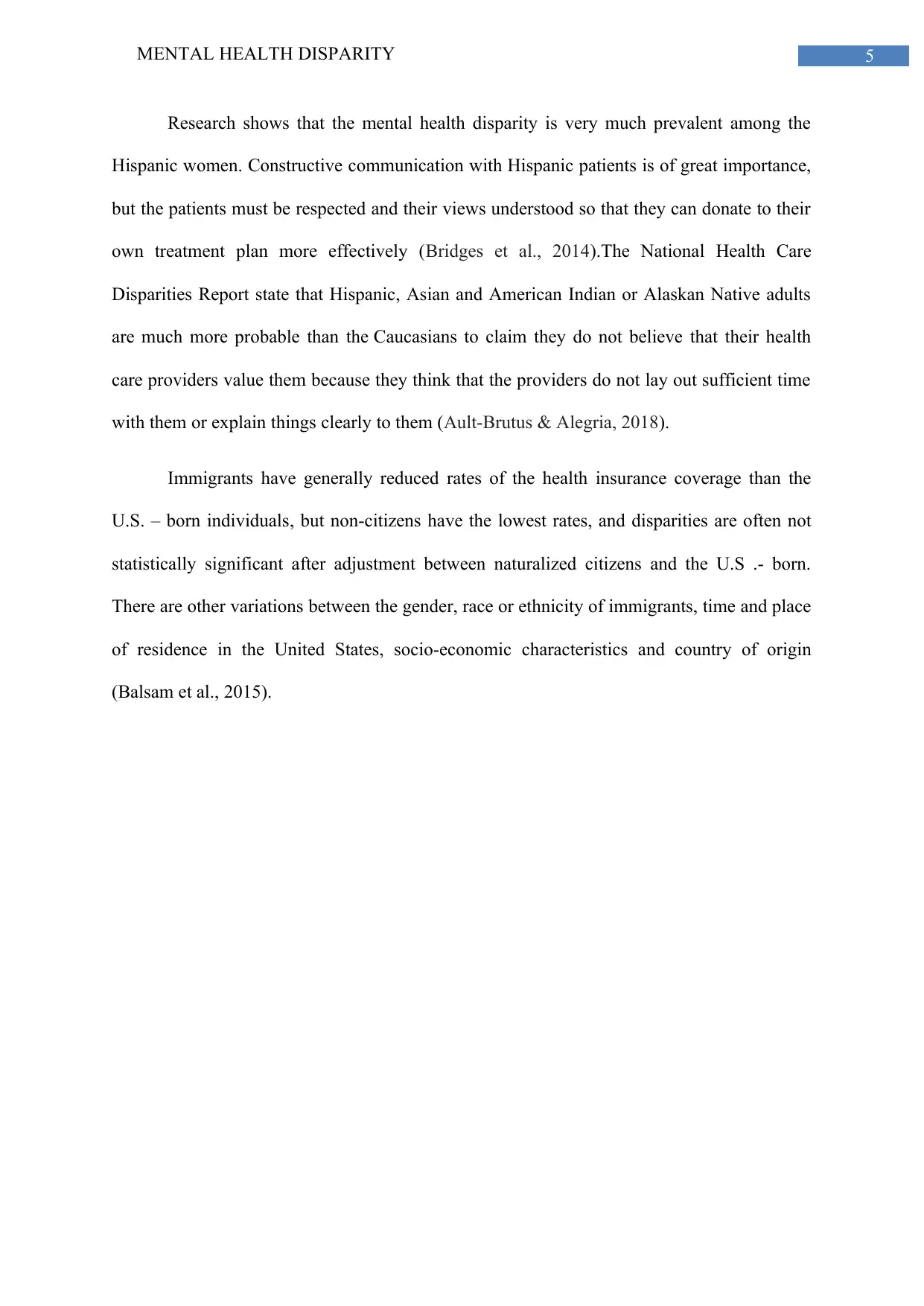
5MENTAL HEALTH DISPARITY
Research shows that the mental health disparity is very much prevalent among the
Hispanic women. Constructive communication with Hispanic patients is of great importance,
but the patients must be respected and their views understood so that they can donate to their
own treatment plan more effectively (Bridges et al., 2014).The National Health Care
Disparities Report state that Hispanic, Asian and American Indian or Alaskan Native adults
are much more probable than the Caucasians to claim they do not believe that their health
care providers value them because they think that the providers do not lay out sufficient time
with them or explain things clearly to them (Ault-Brutus & Alegria, 2018).
Immigrants have generally reduced rates of the health insurance coverage than the
U.S. – born individuals, but non-citizens have the lowest rates, and disparities are often not
statistically significant after adjustment between naturalized citizens and the U.S .- born.
There are other variations between the gender, race or ethnicity of immigrants, time and place
of residence in the United States, socio-economic characteristics and country of origin
(Balsam et al., 2015).
Research shows that the mental health disparity is very much prevalent among the
Hispanic women. Constructive communication with Hispanic patients is of great importance,
but the patients must be respected and their views understood so that they can donate to their
own treatment plan more effectively (Bridges et al., 2014).The National Health Care
Disparities Report state that Hispanic, Asian and American Indian or Alaskan Native adults
are much more probable than the Caucasians to claim they do not believe that their health
care providers value them because they think that the providers do not lay out sufficient time
with them or explain things clearly to them (Ault-Brutus & Alegria, 2018).
Immigrants have generally reduced rates of the health insurance coverage than the
U.S. – born individuals, but non-citizens have the lowest rates, and disparities are often not
statistically significant after adjustment between naturalized citizens and the U.S .- born.
There are other variations between the gender, race or ethnicity of immigrants, time and place
of residence in the United States, socio-economic characteristics and country of origin
(Balsam et al., 2015).
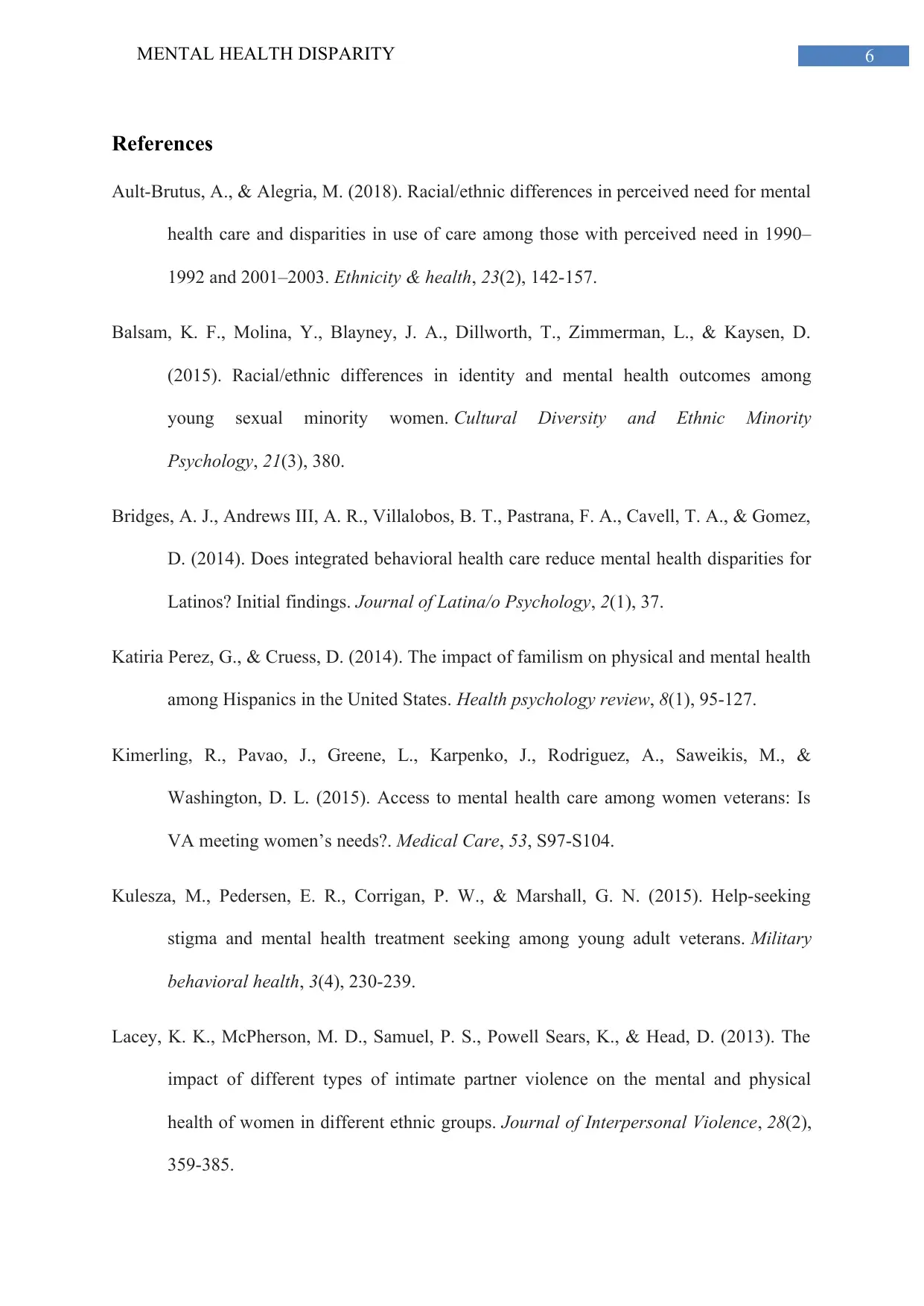
6MENTAL HEALTH DISPARITY
References
Ault-Brutus, A., & Alegria, M. (2018). Racial/ethnic differences in perceived need for mental
health care and disparities in use of care among those with perceived need in 1990–
1992 and 2001–2003. Ethnicity & health, 23(2), 142-157.
Balsam, K. F., Molina, Y., Blayney, J. A., Dillworth, T., Zimmerman, L., & Kaysen, D.
(2015). Racial/ethnic differences in identity and mental health outcomes among
young sexual minority women. Cultural Diversity and Ethnic Minority
Psychology, 21(3), 380.
Bridges, A. J., Andrews III, A. R., Villalobos, B. T., Pastrana, F. A., Cavell, T. A., & Gomez,
D. (2014). Does integrated behavioral health care reduce mental health disparities for
Latinos? Initial findings. Journal of Latina/o Psychology, 2(1), 37.
Katiria Perez, G., & Cruess, D. (2014). The impact of familism on physical and mental health
among Hispanics in the United States. Health psychology review, 8(1), 95-127.
Kimerling, R., Pavao, J., Greene, L., Karpenko, J., Rodriguez, A., Saweikis, M., &
Washington, D. L. (2015). Access to mental health care among women veterans: Is
VA meeting women’s needs?. Medical Care, 53, S97-S104.
Kulesza, M., Pedersen, E. R., Corrigan, P. W., & Marshall, G. N. (2015). Help-seeking
stigma and mental health treatment seeking among young adult veterans. Military
behavioral health, 3(4), 230-239.
Lacey, K. K., McPherson, M. D., Samuel, P. S., Powell Sears, K., & Head, D. (2013). The
impact of different types of intimate partner violence on the mental and physical
health of women in different ethnic groups. Journal of Interpersonal Violence, 28(2),
359-385.
References
Ault-Brutus, A., & Alegria, M. (2018). Racial/ethnic differences in perceived need for mental
health care and disparities in use of care among those with perceived need in 1990–
1992 and 2001–2003. Ethnicity & health, 23(2), 142-157.
Balsam, K. F., Molina, Y., Blayney, J. A., Dillworth, T., Zimmerman, L., & Kaysen, D.
(2015). Racial/ethnic differences in identity and mental health outcomes among
young sexual minority women. Cultural Diversity and Ethnic Minority
Psychology, 21(3), 380.
Bridges, A. J., Andrews III, A. R., Villalobos, B. T., Pastrana, F. A., Cavell, T. A., & Gomez,
D. (2014). Does integrated behavioral health care reduce mental health disparities for
Latinos? Initial findings. Journal of Latina/o Psychology, 2(1), 37.
Katiria Perez, G., & Cruess, D. (2014). The impact of familism on physical and mental health
among Hispanics in the United States. Health psychology review, 8(1), 95-127.
Kimerling, R., Pavao, J., Greene, L., Karpenko, J., Rodriguez, A., Saweikis, M., &
Washington, D. L. (2015). Access to mental health care among women veterans: Is
VA meeting women’s needs?. Medical Care, 53, S97-S104.
Kulesza, M., Pedersen, E. R., Corrigan, P. W., & Marshall, G. N. (2015). Help-seeking
stigma and mental health treatment seeking among young adult veterans. Military
behavioral health, 3(4), 230-239.
Lacey, K. K., McPherson, M. D., Samuel, P. S., Powell Sears, K., & Head, D. (2013). The
impact of different types of intimate partner violence on the mental and physical
health of women in different ethnic groups. Journal of Interpersonal Violence, 28(2),
359-385.
Paraphrase This Document
Need a fresh take? Get an instant paraphrase of this document with our AI Paraphraser
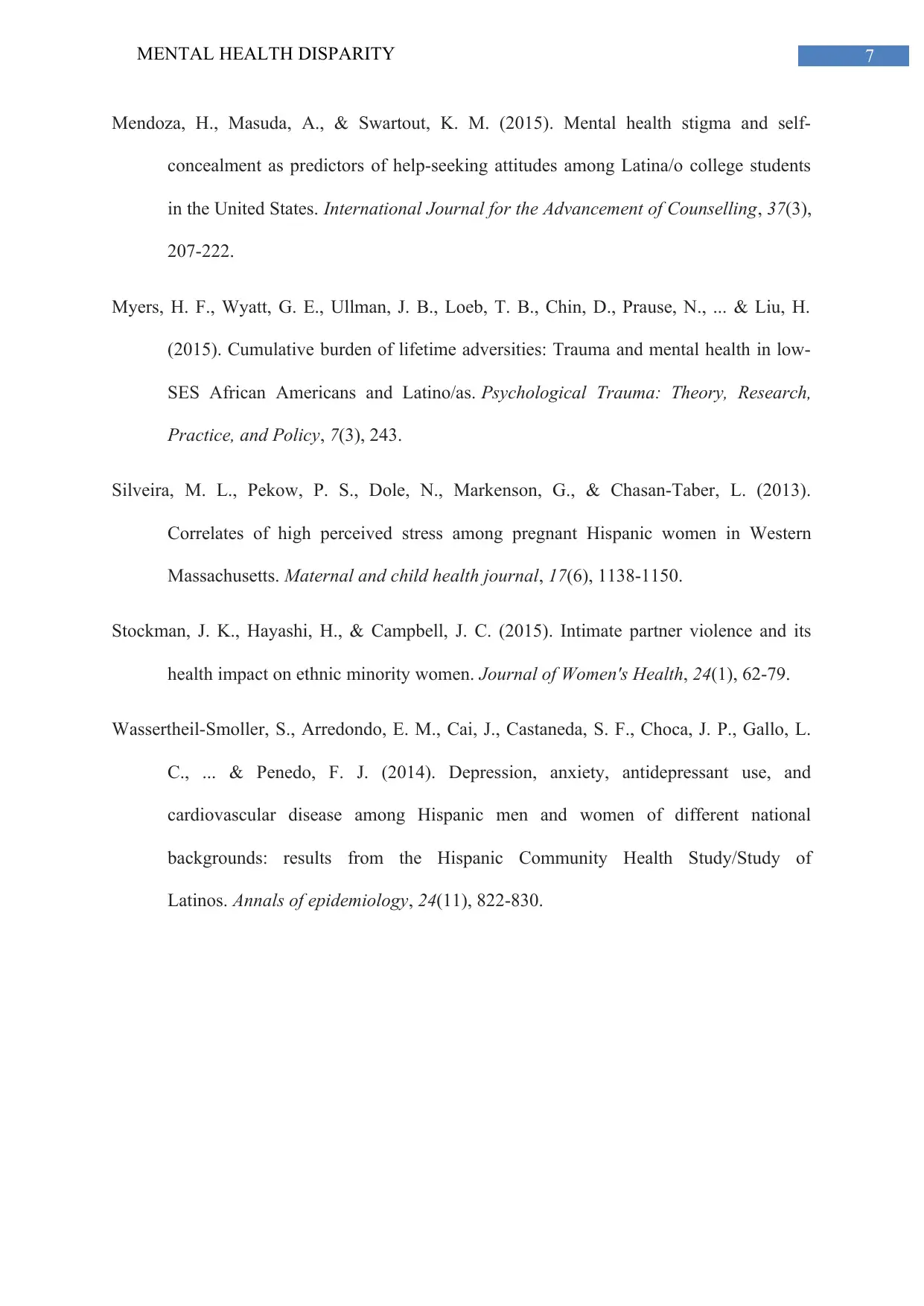
7MENTAL HEALTH DISPARITY
Mendoza, H., Masuda, A., & Swartout, K. M. (2015). Mental health stigma and self-
concealment as predictors of help-seeking attitudes among Latina/o college students
in the United States. International Journal for the Advancement of Counselling, 37(3),
207-222.
Myers, H. F., Wyatt, G. E., Ullman, J. B., Loeb, T. B., Chin, D., Prause, N., ... & Liu, H.
(2015). Cumulative burden of lifetime adversities: Trauma and mental health in low-
SES African Americans and Latino/as. Psychological Trauma: Theory, Research,
Practice, and Policy, 7(3), 243.
Silveira, M. L., Pekow, P. S., Dole, N., Markenson, G., & Chasan-Taber, L. (2013).
Correlates of high perceived stress among pregnant Hispanic women in Western
Massachusetts. Maternal and child health journal, 17(6), 1138-1150.
Stockman, J. K., Hayashi, H., & Campbell, J. C. (2015). Intimate partner violence and its
health impact on ethnic minority women. Journal of Women's Health, 24(1), 62-79.
Wassertheil-Smoller, S., Arredondo, E. M., Cai, J., Castaneda, S. F., Choca, J. P., Gallo, L.
C., ... & Penedo, F. J. (2014). Depression, anxiety, antidepressant use, and
cardiovascular disease among Hispanic men and women of different national
backgrounds: results from the Hispanic Community Health Study/Study of
Latinos. Annals of epidemiology, 24(11), 822-830.
Mendoza, H., Masuda, A., & Swartout, K. M. (2015). Mental health stigma and self-
concealment as predictors of help-seeking attitudes among Latina/o college students
in the United States. International Journal for the Advancement of Counselling, 37(3),
207-222.
Myers, H. F., Wyatt, G. E., Ullman, J. B., Loeb, T. B., Chin, D., Prause, N., ... & Liu, H.
(2015). Cumulative burden of lifetime adversities: Trauma and mental health in low-
SES African Americans and Latino/as. Psychological Trauma: Theory, Research,
Practice, and Policy, 7(3), 243.
Silveira, M. L., Pekow, P. S., Dole, N., Markenson, G., & Chasan-Taber, L. (2013).
Correlates of high perceived stress among pregnant Hispanic women in Western
Massachusetts. Maternal and child health journal, 17(6), 1138-1150.
Stockman, J. K., Hayashi, H., & Campbell, J. C. (2015). Intimate partner violence and its
health impact on ethnic minority women. Journal of Women's Health, 24(1), 62-79.
Wassertheil-Smoller, S., Arredondo, E. M., Cai, J., Castaneda, S. F., Choca, J. P., Gallo, L.
C., ... & Penedo, F. J. (2014). Depression, anxiety, antidepressant use, and
cardiovascular disease among Hispanic men and women of different national
backgrounds: results from the Hispanic Community Health Study/Study of
Latinos. Annals of epidemiology, 24(11), 822-830.
1 out of 8
Related Documents
Your All-in-One AI-Powered Toolkit for Academic Success.
+13062052269
info@desklib.com
Available 24*7 on WhatsApp / Email
![[object Object]](/_next/static/media/star-bottom.7253800d.svg)
Unlock your academic potential
© 2024 | Zucol Services PVT LTD | All rights reserved.





